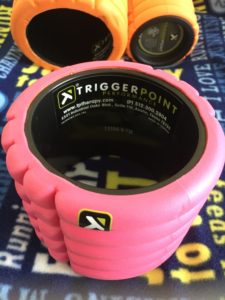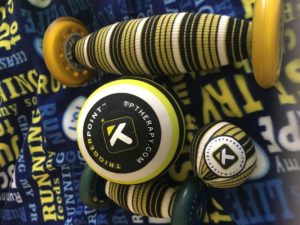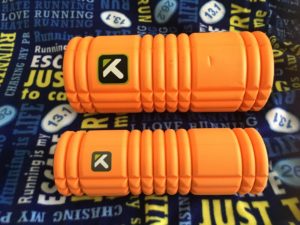Disclosure: I received the gently used Grid and new-in-package MobiPoint Massage Ball as conference swag, directly from TriggerPoint Therapy, one of the sponsors of Sweat Pink’s BlogFest at IDEA World 2019. (I’m only giving them away because I already had my own!) I wasn’t asked to write a blog post, host a giveaway, or anything else for that matter. All opinions and words are my own.
What Have You Heard about Foam Rolling?

If you haven’t heard about “foam rolling,” you’ve probably been living under a rock. There’s WAY more to the world of self-myofacial release (SMFR or MFR) than the foamy logs you see at the Relax the Back store or in your yoga/pilates studio. Essentially, SMFR is a type of self-massage that often involves specialized tools, including various kinds of stick-rollers, log/tube-shaped rollers, balls, and other tools. SMFR techniques manipulate and massage the muscles and surrounding tissues, increasing blood flow and elasticity. In my experience, while there is sometimes a bit of “owww, that’s a tight spot,” the end result is a bit like the end result of a massage: everything feels better.
I first encountered the Grid at an SCW Mania event nearly ten years ago, back when TP Therapy was a small company based in Austin, TX. (It is now owned by Implus, the American parent company of SKLZ, Harbinger, Balega, RockTape, FuelBelt, Sofsole, Spenco, and more.) Their trainers–including Cassidy Phillips, the founder and CEO–taught several practical SMFR sessions. Cassidy taught us a little bit about fascia, the connective tissue that helps form the structure of the human body; it’s like a scaffolding around the bones that helps keep other body tissues and organs in their place. Think of it as a stretchy mesh: if you pull on one corner and wad it up, the rest of the mesh stretches out to accommodate. Fascia does something similar in the body (which is why when your left low back gets tight, you might find your right upper back, or some other seemingly unrelated body part, is also upset). Cassidy also explained that human muscle tissue is just like any other animal muscle tissue; when it is fully hydrated and moving well it is like a tender steak, but when it is partially dehydrated and has knots or spots of uneven tension it is more like beef jerky. (That image has stuck with me, and I’m a more hydrated-human because of it.)
Before I get into why I love The Grid, let’s take a step back. If you’ve tried SMFR you probably agree that it feels good (well, after it stops hurting like hell), and maybe you’ve read some other blogger yammer on about how fantastic it is. That’s all well and good, but fancy tea tastes good and no matter how many bloggers say so it isn’t going to “detox” you (at least not any more than your liver and kidneys already do). So…is foam rolling worthwhile, or is it some woo-woo goop-esque trend?
What Science Says
If you’re a science geek, you probably already know about PubMed. If you are an athlete interested in exercise science, or a person interested in the latest nutrition research, or a blogger who doles out advice on anything related to the human body (including products and ingredients) you really ought to bookmark it. PubMed is a service of the U.S. National Library of Medicine, which is part of the National Institute of Health. PubMed largely includes abstracts of peer-reviewed articles, though a few articles are available for free. The articles include clinical trials, epidemiology reviews, case studies, and more. You can choose to view the results by “best match” or “most recent”
Pro tip: if you don’t want to pay for access to an article, but you really want to read it, you have two free options. One, reach out to the authors of the paper. Many authors are happy that someone wants to read their research, and would be thrilled to send you a copy of the publication. Two, seek out access via a college or university library. If you attended a college or university, start there. Many allow their alumni to use the library resources for free or super cheap. If you didn’t, you can try a nearby college or university. Many have a non-student library card that you can obtain for a fee, and that may include access to electronic resources.
A PubMed search for “foam rolling” returned 83 results! (The more scientific “self myofascial release” returned 100. There is some overlap, of course.) Some of the articles are very general, while others are almost nauseatingly specific, such as Behara B, and Jacobson BH’s “Acute Effects of Deep Tissue Foam Rolling and Dynamic Stretching on Muscular Strength, Power, and Flexibility in Division I Linemen.” J Strength Cond Res. 2017 Apr;31(4):888-892. doi: 10.1519/JSC.0000000000001051. https://www.ncbi.nlm.nih.gov/pubmed/26121431
A Little of the Bad News
There are several articles that cast doubt on what you’ve likely heard about foam rolling.
At least one review concludes that the term “self-myofascial release” is misleading, because there isn’t enough evidence to support the idea that foam rolling and similar practices actually release myofascial restrictions. Behm, DG and Wilke, J. Do Self-Myofascial Release Devices Release Myofascia? Rolling Mechanisms: A Narrative Review. Sports Med. 2019 Aug;49(8):1173-1181. doi: 10.1007/s40279-019-01149-y. https://www.ncbi.nlm.nih.gov/pubmed/31256353 It strikes me that this is a fair conclusion, since the research on foam rolling and similar practices is still pretty young, and it’s entirely possible that any results achieved are from something other than myofascial release, maybe improved blood circulation, or something about how your breathing changes while you are doing it–we don’t know. (But we might, soon!)

Another study concluded that adding SMFR to static stretching did not have an effect on hamstring stiffness, as a group that did only static stretching achieved the same results. Mortin, RW et al. Self-Myofascial Release: No Improvement of Functional Outcomes in ‘Tight’ Hamstrings. Int J Sports Physiol Perform. 2016 Jul;11(5):658-63. doi: 10.1123/ijspp.2015-0399. Epub 2015 Nov 9. https://www.ncbi.nlm.nih.gov/pubmed/26562930
Remember that in order to make sense of any study’s result, you need to take a look at who the participants were (students, professionals, weekend warriors?), what the researchers looked at (how did they measure results? what did they consider or fail to consider?), and the testing protocol (what did the participants actually do? was there a control group?). The results of a small study of college tennis players, for example, may not apply to a Gen Xer who only does Crossfit.
A Little of the Good News
I love the way I feel in my body after a good session with The Grid, so I almost don’t care if there is any science to support it. Since I’m recommending it to you though, I think it would be irresponsible to talk about how great I think it is if in reality it’s a sham like detoxing foot pads or alkaline water. Here are a few studies that found foam rolling or SMFR beneficial–these are the ones I found interesting, but you can go find more on PubMed. The term “key finding” is mine (as some abstracts use “results,” others use “conclusions,” and I like a tidy organization to my references).
Several studies concluded that the protocol they studied led to an improved range of motion:
- Su H, et al. Acute Effects of Foam Rolling, Static Stretching, and Dynamic Stretching During Warm-ups on Muscular Flexibility and Strength in Young Adults. J Sport Rehabil. 2017 Nov;26(6):469-477. doi: 10.1123/jsr.2016-0102. Epub 2016 Oct 13. https://www.ncbi.nlm.nih.gov/pubmed/27736289 Key finding: flexibility test scores improved significantly more after foam rolling a compared with static and dynamic stretching.
- Mohr AR, et al. Effect of foam rolling and static stretching on passive hip-flexion range of motion. J Sport Rehabil. 2014 Nov;23(4):296-9. doi: 10.1123/jsr.2013-0025. Epub 2014 Jan 21. https://www.ncbi.nlm.nih.gov/pubmed/24458506 Key finding: Regardless of the treatment, all subjects had increased range of motion (regardless of treatment: static stretching, foam rolling and static stretching, or only foam rolling). Use of a foam roller followed by static-stretching increased range of motion more than static stretching alone.
- Bushell JE, et al. Clinical Relevance of Foam Rolling on Hip Extension Angle in a Functional Lunge Position. J Strength Cond Res. 2015 Sep;29(9):2397-403. doi: 10.1519/JSC.0000000000000888. https://www.ncbi.nlm.nih.gov/pubmed/25734777
Key finding: repeated foam rolling is beneficial, both objectively and subjectively, for increasing range of motion immediately preceding a dynamic activity.
Several studies concluded that the protocol they studied led to improvement in recovery, including delayed onset muscle soreness (DOMS, or the soreness you get a day or two after your workout):
- Pearcey GE, et al. Foam rolling for delayed-onset muscle soreness and recovery of dynamic performance measures. J Athl Train. 2015 Jan;50(1):5-13. doi: 10.4085/1062-6050-50.1.01. Epub 2014 Nov 21.
https://www.ncbi.nlm.nih.gov/pubmed/25415413
Key finding: Foam rolling effectively reduced DOMS and associated decrements in most dynamic performance measures. - Rey E, et al. Effects of Foam Rolling as a Recovery Tool in Professional Soccer Players. J Strength Cond Res. 2019 Aug;33(8):2194-2201. doi: 10.1519/JSC.0000000000002277. https://www.ncbi.nlm.nih.gov/pubmed/29016479 Key finding: soccer coaches and trainers working with high-level players should use a structured recovery session of 15-20 minutes using foam rolling at the end of a training session to enhance recovery.
Some studies looked at specific health conditions or effects, rather than muscular performance. A few of the ones I found nifty:
- Improvement of Fibromyalgia. Ceca, D et al. Benefits of a self-myofascial release program on health-related quality of life in people with fibromyalgia: a randomized controlled trial. J Sports Med Phys Fitness. 2017 Jul-Aug;57(7-8):993-1002. doi: 10.23736/S0022-4707.17.07025-6. Epub 2017 Jan 31. https://www.ncbi.nlm.nih.gov/pubmed/28139112
Key finding: regular, structured practice of SMFR can improve health-related quality of life for people with fibromyalgia. - Reduction of Arterial Stiffness. Okamoto T, et al. Acute effects of self-myofascial release using a foam roller on arterial function. J Strength Cond Res. 2014 Jan;28(1):69-73. doi: 10.1519/JSC.0b013e31829480f5. https://www.ncbi.nlm.nih.gov/pubmed/23575360 Key finding: SMFR with a foam roller reduces arterial stiffness and improves vascular endothelial function.
In short, while the jury is still out on some claims about foam rolling, there is also some evidence–at least regarding the population and specific protocols studied–that foam rolling provides a benefit. I mean beyond feeling good when you’re done.
Back To The Grid

Unlike the long foam rollers I’d known before, the Grid has a hollow hard-plastic core. (While there is a smaller travel Grid available–think as if you took a slice of the roller–the original Grid is great for travel, as you can stuff a lot of clothing in there inside your suitcase.) On the outside, the Grid is textured in an un-even grid-like pattern: small squares are high and firm, like fingertips or a thumb tip; long and narrow rectangles are more like fingers; and larger rectangular flat areas are like palms. Positioning the Grid so that a particular surface hits the targeted area changes how it feels on your body. Rolling through all of the different zones feels delicious to me! In my first class, we learned techniques to roll out the peroneals, IT band, quads, anterior tibialis, and more.
Also unlike the long foam rollers I’d known before, the Grid is very sturdy. (I’ve had my personal Grid since that first SCW Mania, I’ve toted it around the country, and you’d be hard pressed to tell.) The fact that it is hollow means you can also incorporate it into exercises apart from SMFR. For example, you can hold the sides (palms on top, fingers tucked inside the hollow center) and plank. This adds an extra dose of instability to your plank, as any shift of your body weight forward or back will cause the Grid to roll. Another example exercise is the lunge. Standing with your front foot on the Grid and your back leg in an extended lunge, keep your torso upright and your front leg steady while you drop you back knee to a right angle. Another example is the plank-to-pike exercise: start in a plank with your toes on the Grid, transition to a pike with the soles of your feet on the Grid. Quite possibly my favorite is the wall squat using the Grid between your back and the wall.
Your Only Tool Is a Hammer…Is Everything a Nail?
One of the things that impressed me was that the staff at the TriggerPoint booth were more interested in showing you how to use their tools than selling you the tools. SMFR isn’t something you just do here and there to make a workout smoother, or to recover from a workout. In order to create and maintain results, any SMFR program requires repetition–just like exercise. The TriggerPoint website includes a library of videos on how to use their products (which back in the day we bought on DVD). After using it in a workshop targeted towards runners, I purchased a tools kit (similar to what is now called the TP Performance Collection) that came with a booklet outlining a total body program (including a dry-erase calendar to plan your program); I also bought The Ultimate 6 for Runners–a similar booklet that targets the soleus, qaudcriceps, psoas, piriformis, pectorales, and thoracic spine. I particularly like the booklets. They are spiral bound to lay flat, and have plenty of photographs in addition to the text description.
Today, the TP Therapy products in my SMFR tool kit also include the Grid Vibe (thinner than the Grid, but OMG the vibration is brilliant!), MB5 large foam massage ball, MobiPoint massage ball, and the Nano X foot roller (the extra-dense version of the Nano foot roller). Recently TP Therapy released a new tool, the MB Vibe, which is similar to the MB5 but also has vibration to it. (I cannot wait to get my hands on one!)
Win Your Own!
I have ONE prize pack to give away. It includes The Grid, the original TP Therapy product, in orange; and the MobiPoint Massage Ball (a sweet treat for runner feet!). Apologies to my friends elsewhere, but postage is spendy these days and so I have to limit this giveaway to U.S. residents only. Void where prohibited.
Start by leaving a comment and tell me about your experiencce: Have you tried foam rolling or another form of self myofacial release? Which tools do you use? What’s your favorite exercise? How often do you roll?
Then work your way through the steps in the Rafflecopter widget below. Good luck!



